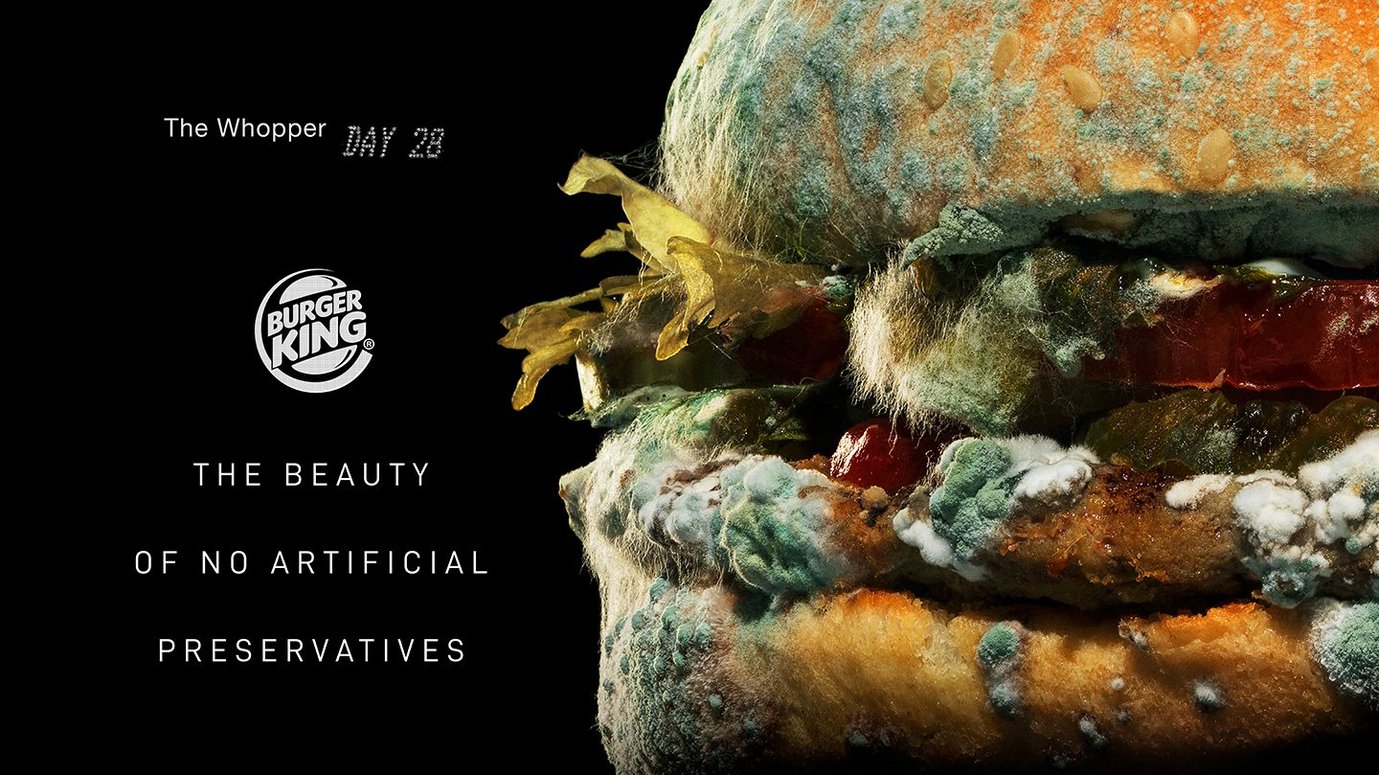04 August 2023 Should ads punch you in the face, or slowly wear you down?
Despite the fact it’s our bread and butter, as an industry we don’t talk enough about how advertising works. Like, how does seeing an ad actually process in your brain? And how does this ultimately influence buying behaviour?
And these are important conversations. The way you think ads work will shape the concepts you turn into campaigns. Or what your clients will buy. Or what creative teams are trying to sell.
So how do ads work? Let’s propose two opposing schools of thought. One which punches you in the face, the other which slowly wears you down. And interestingly you can almost perfectly determine which philosophy you subscribe to based on one question…
“Was Mouldy Whopper a good ad?”

It picked up a suitcase of awards, including the Cannes Lion Grand Prix and an Effectiveness Lion a year later. Here’s why it might just be the most debated ad of all time (at least among marketers).
Is a good ad one which grabs your attention?
The first school of thought suggests the ads that win are the ones which grab attention. They stop you in your tracks. You don’t ignore them because you can’t. And maybe you’re inclined to share them or talk about them.
Their mission is to make the brand famous. Often using that moment in the spotlight to communicate a key message, after you’ve grabbed someone’s attention.
Like this incredibly insightful work from Ikea. It takes a moment to click, but you’re rewarded for doing so.

Since The Long and the Short of It was published a decade ago, we know campaigns which aim for fame outperform those that don’t on all business metrics – sales, markets share, price sensitivity, penetration, and profit.
Salespeople have known this forever. The AIDA Model, which first surfaced in the 1890s, suggests before you can ‘sell’ to someone, you must first do something to grab them. Attention first, then comes Interest, Desire, and Action.
In his book Anatomy of a Humbug, Paul Feldwick explores the many ways ads can influence. He would call this school of thought “advertising as showmanship”. You arrest public opinion and entertain the masses. The results come thereafter. Mark Ritson might call these campaigns “empty but effective“.
When most ads aren’t remembered, this advertising fights to be noticed and recalled.
And if you’re nodding along reading this, you probably like Mouldy Whopper. You believe that being noticed is half the battle. A good ad is one that gets people talking, at almost any cost. You applaud brands like BrewDog, Nike, and Apple.
But there’s a second school of thought.
Are good ads processed implicitly over time?
The challenge with aiming for fame and grabbing attention, is it’s really bloody hard. And often asks a lot of the audience. Which is difficult when you’re driving past a billboard at 110km/h on the highway.
Even when we’re stuck at a bus stop – it’s rare we stop and actively process something. In his book Thinking Fast and Slow, Daniel Kahneman suggests we spend most of our lives in autopilot.
But this doesn’t mean the ads we ignore don’t work. Maybe good ads are the ones which lean into the zombie mode? In their 1997 paper The Attentional Blink, researchers found “Advertising has the potential to affect future buying decisions, even when subjects do not process the ad attentively and do not recollect ever having seen the ad”.
This philosophy is better aligned to the Associative Network Theories of Memory (Anderson and Bower, 1973), which suggests the brain builds associations slowly over time. For advertising, ideally, it’s connecting your brand to a need.
It’s not an argument for wallpaper. You still want these ads to be disruptive. Break conventions, be creative and elicit emotion.
But these they tend to be simpler. Easy gets. Your brain processes them implicitly. Only if they’re well branded (which is why Distinctive Brand Assets are so critical).
Consumers don’t have to be leaning in for ads to work.
And this can be contentious. Byron Sharp of How Brands Grow calls this ad “an excellent example of how great branding and creativity can work with a mere second of attention”. This ad doesn’t stop anyone in their tracks. But it’s not meant to.

Personally, I don’t see a lot of great creativity here. But the argument is for clarity and branding, connecting to a need.
Insurer AAMI have, for decades, been creating mildly amusing ads. None of which aim for fame, but slowly and surely build associations between the brand and insurance needs. They’re incredibly well branded. And they work hard.
In this school of thought, you embrace the fact that advertising is a weak force, which works very slowly.
And here, you probably don’t like Mouldy Whopper. The compelling argument against is that it simply builds associations of mould and disgust. The key message is buried behind a wall of attention your average punter won’t break through.
So which one is right?
You need jabs and right hooks.
The answer is both. The ideal marketing plan allocates opportunities for both schools of thoughts. A mix of hard-working-but-slow-and-steady ads in the background, and big moments in the sun which aim for fame (which are also hard working).
KFC have the right balance. Their marketing plan is built on ongoing campaigns like Did Someone Say KFC? (brand = long) and Shut Up And Take My Money (sales activation = short). And sprinkled between are big culture grabs like Michelin Impossible and KFC Weddings. And they can’t seem to stop winning effectiveness awards.
But most importantly, whichever school of thought you subscribe to, let’s talk more about it. Have a conversation (or debate). Ask your clients/agency where they stand.
Don’t try to pack a punch if your client is looking for something that simmers. Or vice versa.
Zac Martin is a Planning Director at TBWA\Melbourne. This article was originally published on Mumbrella.

No Comments